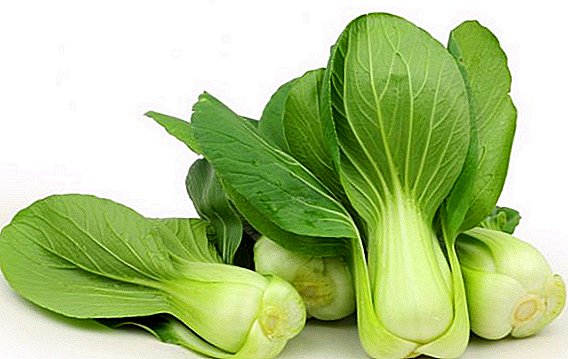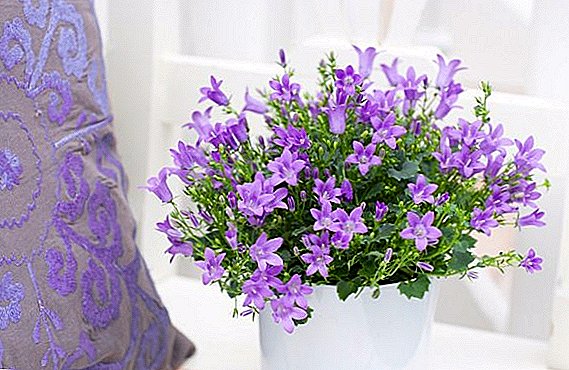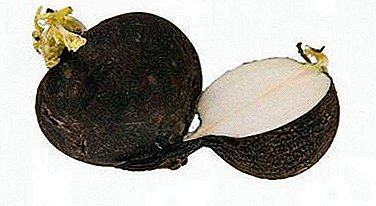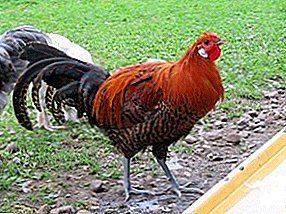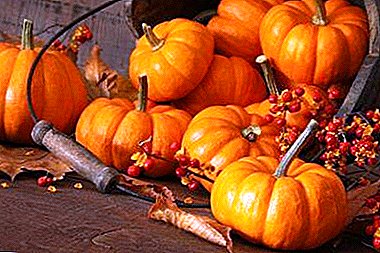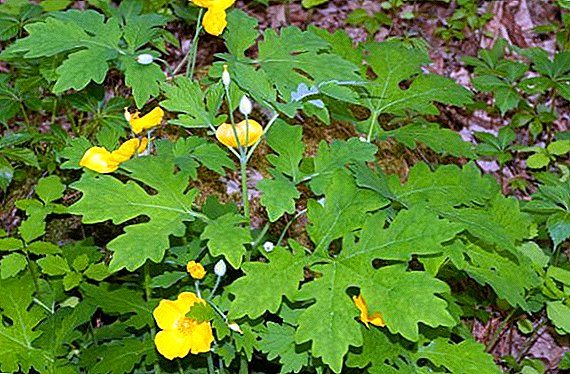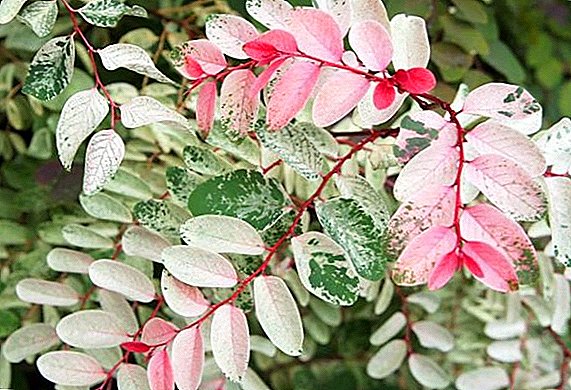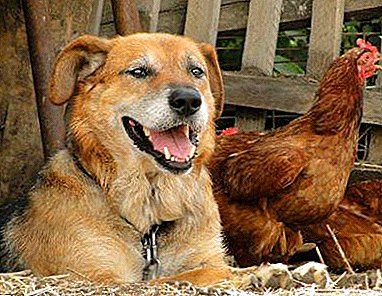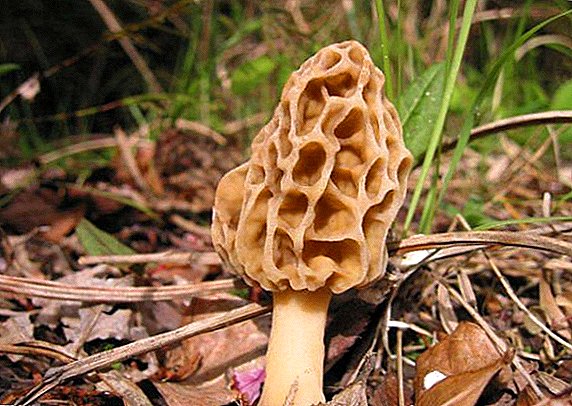 In the human diet is present plant and animal food. There are also organisms that do not fall into any of the categories. These are mushrooms. They are isolated in a separate kingdom and divided into edible and poisonous. There is a separate category of mushrooms - conditionally edible. Inexperienced mushroom pickers are forbidden to collect and eat them, as there is a high risk of poisoning by an inedible representative. One of these conditionally edible mushrooms is morel. In this article, species of morels, their distribution range, methods of growing and cooking of these mushrooms will be considered.
In the human diet is present plant and animal food. There are also organisms that do not fall into any of the categories. These are mushrooms. They are isolated in a separate kingdom and divided into edible and poisonous. There is a separate category of mushrooms - conditionally edible. Inexperienced mushroom pickers are forbidden to collect and eat them, as there is a high risk of poisoning by an inedible representative. One of these conditionally edible mushrooms is morel. In this article, species of morels, their distribution range, methods of growing and cooking of these mushrooms will be considered.
Are edibles more like
It is believed that according to its taste characteristics this species is not inferior to elite truffles. In Europe, it has been harvested as a gourmet culture for more than two hundred years; Slavic countries have not yet recognized the benefits of this mushroom.  It can really be eaten, but only after special processing. Even if morels are planned to be baked or fried, they need to be boiled beforehand in plenty of water.
It can really be eaten, but only after special processing. Even if morels are planned to be baked or fried, they need to be boiled beforehand in plenty of water.
Important! Growing these mushrooms at home is very difficult. Do not expect that they will grow habitual mycelium. Each year, morels appear in a new place, so most often they are grown as an auxiliary crop in orchards.
The resulting broth must be drained, since all the toxic components of the fetus are transferred into it. This product is not subject to marinating and salting, but it is widely used in dried form.
However, after drying it must be kept for three months (the period of toxin disintegration). 
Botanical characteristics and types of morels
Morel is a classic marsupial. There are three main types of morels.
Find out what useful properties such mushrooms as have: flakefish, cheeses, shiitake mushrooms, reishi mushrooms, white heavy trucks, pigs, ceps, boletus, milk mushrooms, boletus mushrooms, chanterelles, boletus mushrooms, boletus mushrooms and champignons.
Morel edible
A rather large (up to 20 cm in height) fruit that has an ovate, slightly elongated cap with a blunt end. Hat tightly fused with the body of the leg, reaches 7 cm in height and is half the growth of the fungus.
Very porous, hollow inside, resembles wax cells. The color is not pronounced gray, slightly ocher, by the autumn it becomes darker, and the fungus hides better in the foliage. The fruit body is fleshy, elastic, also hollow, which makes the fungus very light.
Leg cylindrical shape, closer to the ground thickens and overgrown with scales. Over time, it acquires a brown color; in young mushrooms it is entirely white. The flesh does not have a pronounced smell, it has practically no taste. The structure is thin, fragile, easily damaged and crumbled.  The mushroom propagates by spores of several microns in size. They form a spore brick-colored powder that appears in special bags on the surface of the cap. Sometimes the entire cap is covered with spores.
The mushroom propagates by spores of several microns in size. They form a spore brick-colored powder that appears in special bags on the surface of the cap. Sometimes the entire cap is covered with spores.
Did you know? In the Slavic countries, this culture is not particularly revered, but residents of Europe and the United States consider it a delicacy. In the 1980s, the state of Minnesota made morels its official mushroom, and a few decades before, in the 1910s, the United Kingdom recognized this culture as a national treasure.
Morel conical
It is represented by a fruit body, apothecium, which is elevated above the ground on a thick cylindrical stem. It has a more elongated cap with thin-walled cells. The cells are strongly elongated, resemble a loose sponge. They have a brown-brown color, so they are almost invisible in the foliage. Darken by the end of the mushroom season.
The cap is hollow, as is the dense cylindrical leg. The leg has a loose, somewhat granular structure.  The older the fruit, the darker it becomes. Young morels have a cream or light yellow stem. The flesh is too fragile, slightly wax, dries quickly after cutting, has no pronounced taste and smell. The spore powder is ultralight, represented by smooth oval spores of white or cream color.
The older the fruit, the darker it becomes. Young morels have a cream or light yellow stem. The flesh is too fragile, slightly wax, dries quickly after cutting, has no pronounced taste and smell. The spore powder is ultralight, represented by smooth oval spores of white or cream color.
Morel high
Apothecia is large, up to 20 cm in height and 8 cm in diameter. The cap of the fruit body is narrow and elongated, not as wide as that of a morel edible. It has a dark olive or deep brown color. The leg is similar to the leg of the conical representatives - granular, light, hollow inside.
Important! Small children are prohibited from feeding these mushrooms. Even pre-boiling destroys only part of the toxins in these fruits. Toxins remaining in the dish can harm the immature children's body and cause serious problems with the nervous system.
The older the fungus, the darker it becomes. Ellipsoidal spores form a spore powder of a delicate cream shade. It is stored in the cells and covers the cap of the mushroom. 
Where do mushrooms grow: ecology and distribution
This culture is found throughout the Northern Hemisphere in areas with a temperate continental climate. He also caught on in the least arid regions of Australia. Growing alone, two or three mushrooms together are rare.
It never appears twice in the same place, so there is practically no industrial cultivation of these mushrooms. It grows on limestone soils, well-lit areas, ashes and ditches.
Did you know? For the first time at home, morels tried to cultivate in the 1890s. A Frenchman of Russian descent by the name of Repin laid the mycelium in pots for pots and dug them into a wet ditch. Morels have sprouted ten years later and after harvesting more than once in pots never appeared.
In coniferous forests is rare, more often in deciduous forests, orchards. The season of these mushrooms lasts two or two and a half months - from April to May or the beginning of June.
It is necessary to collect this crop from the beginning of May, since in April the fruits are tasteless and watery. Large groups can be found on the old forest burrs, under fallen trunks and near berry bushes. Cut them gently around the ground itself so as not to damage the fragile leg.  The safety of mycelium is not very important, since every year these fruits appear in a new place. Within two hours after collecting the morels, they need to be cleaned and processed so that they do not dry out and do not become too hard.
The safety of mycelium is not very important, since every year these fruits appear in a new place. Within two hours after collecting the morels, they need to be cleaned and processed so that they do not dry out and do not become too hard.
Can it be confused with other types of mushrooms?
Morels are not like any other fungus, so confusing them with a poisonous false-mushroom is impossible. There is only one species similar to this fruit, the lines. The lines are also brown or brown-brown, but their cap has no cells.
We advise you to read in more detail how the morel differs from the line.
It is shapeless, closes the layered leg almost to the ground. The lines also refer to conditionally edible, so even if you inadvertently collect both mushrooms and others, after boiling, they will become harmless.
How to grow mushrooms
For a long time it was believed that it was impossible to grow morels commercially.  Resourceful Europeans for decades have watched this whimsical culture and brought out some patterns of care for them.
Resourceful Europeans for decades have watched this whimsical culture and brought out some patterns of care for them.
We advise you to learn how to grow at home: mushrooms, mushrooms, oyster mushrooms and black truffle.
German way
In order to bring morel mushrooms to the culture soil, they are collected in the forest and washed gently, retaining water. Peeled fruits are cut into small pieces and scattered in the thick grass at the roots of fruit trees. Landing sites are sprayed with water from washing, in which mushroom spores remain, and poured with ash abundantly.
Planting is left in this form until October, and then covered with fallen apple and birch leaves.  At the end of March, the layer of leaves is removed, the mycelium warms up and dries out, and in early April, the first mushrooms begin to appear. Such planting will give an average yield for three to four years.
At the end of March, the layer of leaves is removed, the mycelium warms up and dries out, and in early April, the first mushrooms begin to appear. Such planting will give an average yield for three to four years.
Important! When growing morels on home gardens, remove the protective layer of leaves by hand. Rakes and special brushes for collecting leaves loosen the upper layers of the soil, thereby injuring the thin threads of the mycelium.
French way
It is based on the fertilization of mushroom beds with apple cake. Landing is carried out in the same way as in the German way, but before covering the ground with foliage, the beds are plentifully covered with rotten apples and other apple waste.
Dry straw is suitable as a shelter, it will ensure the safety of the mycelium during severe winter frosts.
How to properly and tasty cook morels in a pan
There is no exact information about the toxicity of these fungi. Various studies indicate the presence in them of the toxin hiromitrina and poisonous helwellic acid. Both of these substances are destroyed after heat treatment, so this species is considered conditionally edible.
Required Ingredients
To prepare the dishes we need:
- morels - 400 g;
- onion - 100 g;
- butter - 50 g;
- sour cream - 100 ml;
- water - 2 l.
Step-by-step recipe with photos
- Rinse the mushroom mass in cold running water, refresh the slices on the legs and cut the mushrooms alongs Clean them of ground residue, rot and damaged areas.
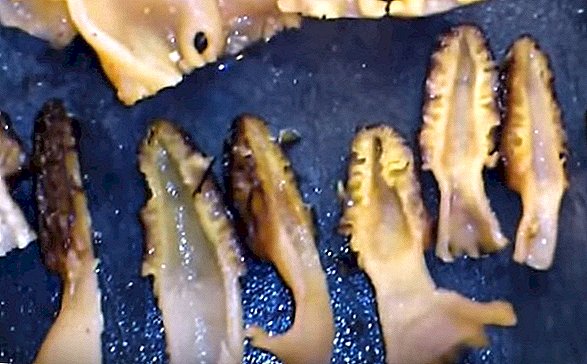
- Fill morels with warm water and soak for half an hour to make the fruit body more elastic.. Drain, pour boiling water over mushrooms and simmer for 40 minutes over low heat.
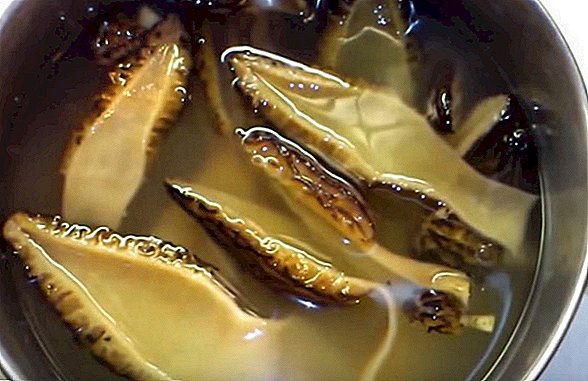
- Meanwhile, peel and finely chop the onion. Melt the butter in the pan. Fry onion until light golden brown. Drain the mushroom broth, transfer it to the frying pan and fry with the onions, stirring gently, for 20 minutes.
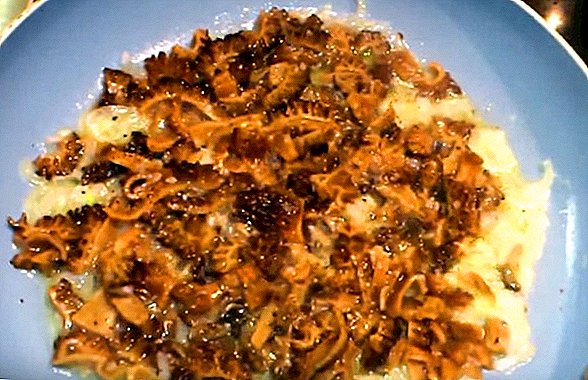
- Add sour cream and simmer for 10 minutes. Arrange the prepared dish in plates and serve hot.
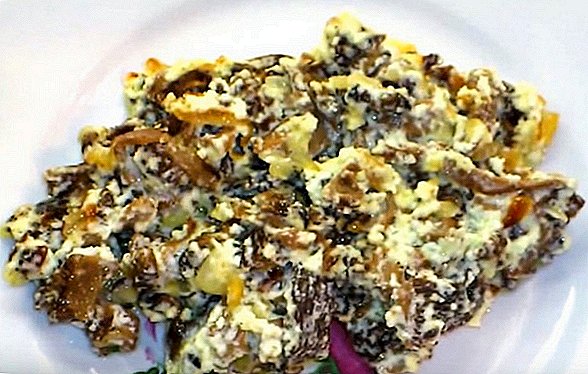
Video: how to grill fried morels
Read more about pickles, pickling, drying and freezing mushrooms.
Whether all can eat morels
It is not recommended to use these fruits with individual intolerance and allergy to mushroom products. Morels are contraindicated in pregnant women, women who breastfeed, children under twelve years of age.
Should not eat them to those who suffer from diseases of the cardiovascular system. Accidentally remaining toxins in the mushroom dish can provoke acute poisoning and complications of existing diseases.
Morels are mushrooms that appear in early spring in the forest and in the garden plots. They grow every year in a new place, preferring well-lit areas of ashy soil. It is necessary to collect them carefully, as the fragile body of the fungus can easily be damaged and crumble.  Before basic preparation, these fruits must be rinsed in cold water and boiled for half an hour so that all toxins contained in them are destroyed.
Before basic preparation, these fruits must be rinsed in cold water and boiled for half an hour so that all toxins contained in them are destroyed.
Did you know? For the first time, a mycologist from San Francisco received a laboratory crop of this crop. He had long counted on the ideal substrate for morels and eventually settled on steamed wheat shoots. Due to the high cost of commercial distribution of this method has not received.
Regular use of morels has a beneficial effect on vision - it eliminates cataracts, glaucoma, and age-sightedness. Observe the measure in the use of these mushrooms and always subject them to heat treatment in order to extract from them only benefit.






